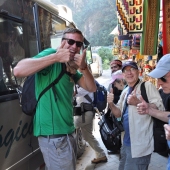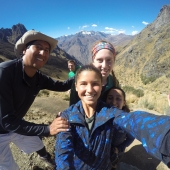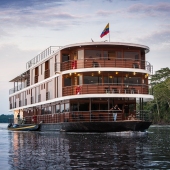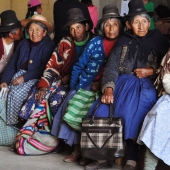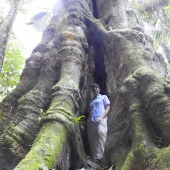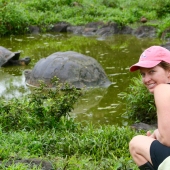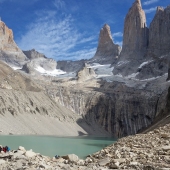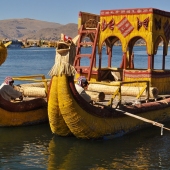
How to Handle Money while Traveling in Peru
Should travelers to Peru carry cash, or use credit cards and ATMs? All options are available for accessing cash, and paying with credit cards or money while traveling, but which one is best? It's as safe to carry cash in Peru as it is to carry cash anywhere. We provide detailed guidelines to help you prepare to travel with cash or credit cards. The most useful "Golden Inca Rule" to be aware of? Cash is King!
Speaking of Money! Are you looking for the best gear for adventure travel? I used this gear and loved it enough to set up links. There's even a discount code for the best water filter for travelers! CLICK HERE for details. And if you have questions about travel in Peru, please email us anytime: info @ AdiosAdventureTravel.com
-
What currency is accepted in Peru?
Nuevo Peruvian Soles and US Dollars are widely accepted in Peru. However, there may be a slight disadvantage when paying with USD. The cost of a product or service could be slightly higher if you pay in USD, lthough usually not a significant amount. But if you have any doubt, ask before you agree to the terms of payment and know what the up-to-date exchange rate is. - Should you carry cash or credit?
The answer is both. But if you want to choose only one, "Cash in King." Hotels and restuarants catering to the lovers of luxury have accepted and integrated the cost of doing business with plastic more than hotels and restaurants that cater to budget or tourist class travelers. Be aware that if you pay for anything in USD, the cost might be slightly more than if you pay in local currency. - Most important tip for paying with credit cards in a foreign country
Let's say you have a credit card that does not charge a fee for transactions in foreign currency. It sounds like a very convenient way to conduct business and minimize the cash you have to carry. There is one important rule to be aware of. In order to get the benefit of a card that does not charge a foreign transaction fee, that transaction must be processed in local currency. The hotel or restaurant may not understand this. So it's up to you to verify. If the transaction is processed in USD, then you may be paying a hidden fee to convert to USD before the transaction reaches your bank. Once you get home and check your statement it's too late to make changes. - Have you heard the rumors that foreign cash and US dollars must be in perfect condtion?
The rumors are true. No one knows why, not even the Peruvians! But in Peru, (and Bolivia) the condition of every US bill is scrutinized by everyone who accepts cash. This includes bank tellers, cambios (money exchange houses) and corner grocery stores. Here is a photo to illustrate the kinds of flaws that may result in bills being rejected. The value of the bill is irrelevant. The bills on the left side of the photo have no flaws. - Can you use ATM machines?
Yes, ATM machines are readily available in Lima, Cusco, Aguas Calientes, Puno, Arequipa & Huaraz. If you plan to arrive in Cusco and go straight to a hotel in the Sacred Valley, make sure your hotel has a nearby ATM AND, most importantly, find out if it is maintained. ATMs in Ollantaytambo and Aguas Calientes are unreliable. Plan ahead if you need cash. ATMs allow withdraw of up to $300 USD or equivalent soles per day, per account. There is no ATM in or near the main entry to Machu Picchu. The nearest ATM is in the village of Aguas Calientes. "Pickup" tour guides are now located at the bus stop in Aguas Calienets. So you shouldn't need access to a cash machine at the entrance to Machu Picchu. We have reports that Machu Picchu bus tickets are best paid for in cash at the bus stop (unless you buy online in advance).. If you want to hire a tour guide for Machu Picchu, here's more info. - Which Credit Cards Should you travel with?
VISA and MASTERCARD are most widely accepted. AMEX is accepted more frequently now, but mainly in the luxury hotels and upscale restuarants. - Where's the best place to exchange cash?
If you can hold off until you get to Cusco, the best place to exchange your dollars (or Euros) for Peruvian soles, is on Ayacucho Street, just off the main Avenida El Sol. Look for small glass-enclosed cambios sharing space with a small retail store. Otherwise, you will find cambios and ATMs at Lima airport and Cusco airport. - Ask your tour guide
Tour guides often get tipped in USD and they know where to exchange currency for the best rates. And they may know where ATMS are out of service or likely to have limited cash on hand. Don't hesitate to ask your tour guide for advice about where to access ATMs or cambios.
What's the latest dilemma to affect visitors going to Machu Picchu?
People are finding out the hard way that not all circuits at Machu Picchu include access to the upper terrace for the classic, iconic snapshot of Machu Picchu. Click here to read more.
What do you need to know about drinking water in Peru?
The first thing to know is that visitors should not drink water from the tap even when brushing their teeth. CLICK HERE to read more and to check out the best little water filter you never heard of and why it's perfect for travelers. There's even a discount code for our loyal followers!


